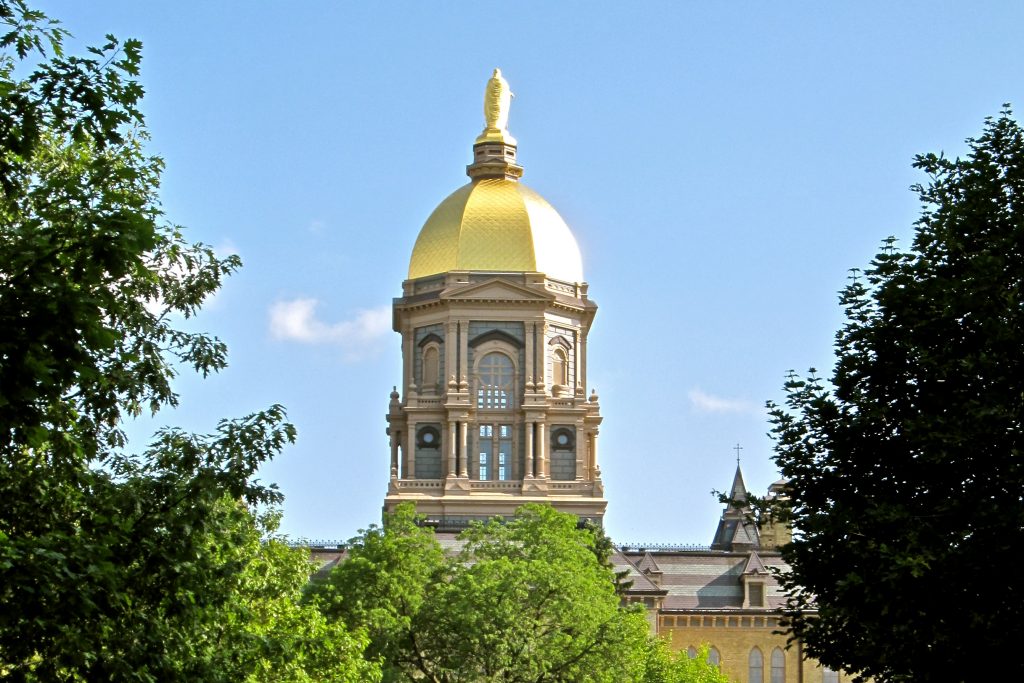Every year we begin our academic year, as many colleges and universities do, with the convocation of faculty. Our president always addresses this gathering. This year, however, she informed us that she could not be present, as she would be attending a celebration of the fiftieth anniversary of the Land O’ Lakes Statement (LOL) rethinking the meaning of a Catholic university.
I wish she had not done so. It is nothing to celebrate.
Indeed, it is a study in confusion and desperate longing to be accepted by those who fashion themselves superior. That longing is apparent in the claim of the opening sentence. It declares that a Catholic university “must be a university in the full modern sense of the word,” including “true autonomy and academic freedom in the face of authority of whatever kind, lay or clerical, external to the academic community itself.” The confusion makes itself apparent right from the Preamble, which informs us that there was no attempt to present a cohesive philosophy; the statement is “selectively and deliberately incomplete.” This perhaps accounts for the fact that the signatories believe that such an institution can be Catholic if it “adds to the basic idea of a modern university distinctive characteristics which round out and fulfill that idea.”
In a previous essay at Public Discourse, I addressed the incoherence of the modern university project as laid out a century ago by the American Association of University Professors. The logical consequences of that project are being played out in ghastly fashion on the campuses of our contemporary universities, including most Catholic ones. No one should want to create or sustain a university conceived in its image. There are, however, two other reasons why the LOL university is wrongheaded. First, LOL, like the AAUP, commits a category mistake. Because of this, LOL fails to recognize that the modern university project and the Catholic university project are utterly irreconcilable.
Start your day with Public Discourse
Sign up and get our daily essays sent straight to your inbox.There Is No Such Thing as a “Pure University”
In its defense of academic freedom, the AAUP declares that the activity of the university is the pursuit of knowledge, no matter what its content or consequences. To perform this activity, the methods used must be determined only by its practitioners. With regard to the pursuit of knowledge, there can be no fealty to any authority outside the academic disciplines themselves, nor can there be any commitment to any set of claims to truth other than those discovered by the scientific methods of the disciplines. They must have “true autonomy” from any authority external to the university. Without this kind of autonomy, the institution is not a true university at all.
Following this lead, LOL accepts the idea that there is such a thing as a pure university, to which such descriptors as “Catholic” (or “liberal arts” or “military”) can be appended without altering the thing itself, like sticking pins in a pincushion.
In making these claims, the AAUP seems to be identifying the essence of the university: the pursuit of knowledge for its own sake. Here, however, lies the category mistake. Think about a ball. What kind of ball, you might ask? Precisely. There is no such thing as a pure ball. Balls are all balls of different kinds. There are baseballs, tennis balls, pimple balls, handballs, beach balls, basketballs, bowling balls, ball bearings, balls and chains, wrecking balls. If my wife sends me out to buy a ball for our year-old son, and I return with a twelve-pound cannon ball, it will not appease her one bit to point out that it is a ball, and I found it for fifty cents at a rummage sale. It will not do; my son will be unable to play with it and will likely be harmed by it.
There is no such thing as a pure ball. Each kind is made for particular purposes. Granted, there are certain features that are essential to balls: for example, they are generally spherical, though sometimes elliptical. There are other characteristics that are usually non-essential, such as their color. Still, it would be absurd to claim that, because the ball has the essential characteristic of being round, this explains everything. Nobody makes pure balls. Ball manufacturers make specific kinds of balls for specific purposes.
So it is with the university. There is no such thing as a pure university. Certainly, human beings can pursue knowledge purely for the sake of pursuing knowledge, but this explains nothing about why human beings pursue knowledge in the ways that they do, and in particular why anyone would go to all the trouble and expense of pursuing it as the modern university does.
As we discovered in my previous essay, the modern university pursues knowledge with a goal in mind: “Social Progress,” usually understood in a material way. Knowledge only counts if it is such as to move us toward that goal. Any kind of claim to truth that does not flow from the methods of the disciplines—say, the personal testimony of many human beings who claim to have directly encountered God—is not discoverable by the academy, and ipso facto is not knowledge. Thus, an institution that holds such religious claims as true and binding on anyone, especially on scholars, is allowing an authority outside the university community to influence the pursuit of knowledge, and ipso facto is not a true university. In other words, the purveyors of this definition of a real university have ruled out by definition the very possibility of a religiously grounded university, and the possibility that the central knowledge claim of such an institution is any kind of knowledge at all.
Sadly, the signatories of LOL had no trouble swallowing the external authority of the AAUP not only concerning the nature of the pure university, but also concerning what counts as knowledge. Thus, the central truth claim must be shoved to the periphery—and it has been, with devastating effect. Catholicism is treated at the Catholic university like one of its buildings: we could get rid of it, and we would still have the same university. We could also do the reverse: add a chapel, a smattering of Catholic professors, maybe the name of a saint and voila! A Catholic university! The question, of course, is why anyone would ever have thought to do such a thing, or would ever want to.
The Animating Principle of the Catholic University
For Catholicism—that is, the institution that gave us the university to begin with—these claims are dangerous nonsense. There can be no university that is a pure university. Each one is founded with a goal in mind. The raison d’etre of a university that claims to be Catholic must be its central truth claim, the Gospel. As put forward by the teaching authority of that Church, in the Apostolic Constitution Ex corde ecclesiae, the Catholic university is born from the heart of the Church. It is first Catholic, and it is a university because this is a properly human way to pursue knowledge, and pass on knowledge, that honors God.
Here we can plunge into the bracing waters of that message and that mystery. We can ask all the questions that the secular version of the university wants to ask, not only in the cramped context of material reality, but in the broader context of all creation. We ask whether we can know God without revelation. We ask what it means to be a human being and to live in human society. We ask about the world, in all its wonder and beauty, its material reality, and what sustains it in existence. We ask how we ended up in such strife with one another, and with such attitudes of domination over the created order—and whether there are any ways out of our strife.
If this were not the animating principle of the Catholic university, there would never have been Catholic universities. Because of this, Ex corde notes that its essential characteristics include the Christian inspiration of its members, continuous expansion of knowledge in the light of faith, its institutional faithfulness to the Gospel as that is given by the Pope and bishops, and thus its institutional commitment to service in faithfulness to the Gospel. It seeks knowledge first, because God has made us knowers, and given what it finds out, it seeks to care for others, because God has made us lovers.
The Catholic university scholar does not look at nature as a foreign entity from which “her intimate secrets” must be torn and processed into useful nuggets. We are not the creators of knowledge. Rather, this careful uncovering of what nature holds is a project to be undertaken only with the deepest humility. Our examination of reality is a slow dance with the created order—an order that can be understood and forms an intelligible whole, since its source is One. It is a dance of slow unveiling and wonder, but one that cries out to be shared. We are not competitors for intimacy with what can be known, but mutual cooperators working toward the same end. But because we are each so small, and our disciplines so limited, we must constantly strive to integrate knowledge through the overarching disciplines of philosophy and theology, the scope of which is Everything.
The University and the Magisterium
LOL puts the final nail in its own coffin by buying in to the modern university’s arrogant notion that its job is to be both the mind and conscience of society. LOL adds to this the idea that the new-era Catholic university will perform this same function for the Church. “Every university . . . serves as the critical reflective intelligence of its society…. the Catholic university has the added obligation of performing this same service for the Church.”
In other words, it sets the university up as a magisterium of the Magisterium, or at least as a parallel magisterium. However, the Catholic university project as envisioned by the Church does not reject all authority outside the academic disciplines, for it realizes that not all truth is attainable through the academic disciplines. In this respect, the Church’s teaching authority (and that of the local bishop) is not thought of as extrinsic to the university project. Furthermore, in humility, it realizes that its reach is limited to the particular disciplinary methods it employs. As such, it is as academically free as any other institution—and frequently, it is more free, since there are no “beaten causes” that are no longer worthy of human inspection. The Catholic university is afraid of no issue, because it begins from a conviction that the truth is One.
Thus, the LOL version of the university is fundamentally anti-Catholic. It adopts the modern university project as its own—a project that we have already shown is rotten at its core. Yet even if it were not, LOL commits the same category mistake as the modern university project, taking it as given that there is such a thing as a pure university, and that other features (like Catholicism) can be added or dropped without effect to the fundamental project of the institution. Most importantly, in order to be considered a university at all by those who fancy themselves the arbiters of what counts as knowledge, the Catholic university must abandon its fundamental truth claims and its proper relationship with those entrusted with the proclamation of that truth. These are the conditions for sitting at the table with the popular kids.
The Land O’ Lakes Statement: Fifty years ago, we should have laughed out loud. Now, it is no laughing matter.













